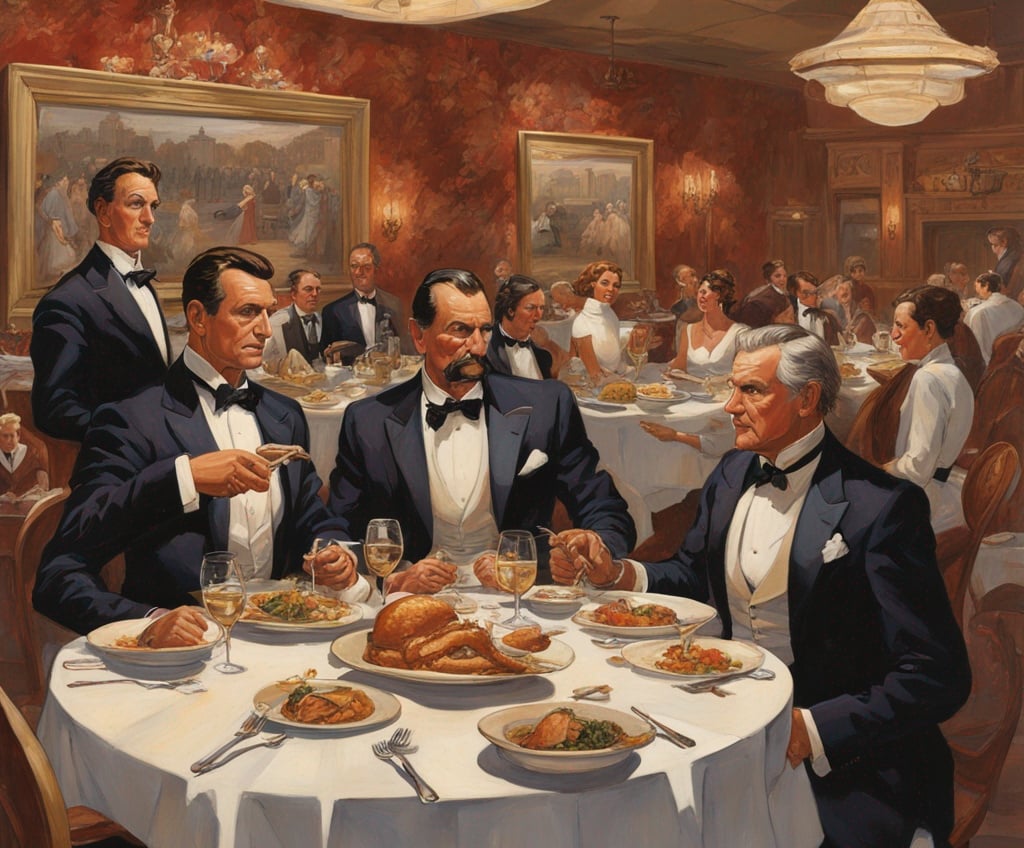Gentlemen's Club
From Formal Affairs to Phone-First Dining: How Generations Experience the Dining Table
ART
5/7/20255 min read


The painting before us captures a scene that feels increasingly distant from today's reality—gentlemen in formal attire gathered around a white-clothed table, engaging in conversation over an elaborate meal, not a smartphone in sight. This image serves as our starting point for exploring how the dining experience has evolved across generations, with particular focus on the contrast between traditional dining culture and Gen Z's revolutionary approach to eating.
The Golden Age of Formal Dining
The mid-20th century represented what many consider the golden age of formal dining. Meals were events, particularly in upscale establishments and private clubs like the one depicted in our painting. Dining out meant dressing appropriately—often in black tie for men and elegant dresses for women. The restaurant experience was characterized by:
Ceremonial service: Multiple courses presented with flourish by skilled waitstaff
Detailed etiquette: Strict rules about everything from napkin placement to which fork to use
Conversation as centerpiece: The art of discussion was paramount, with business deals and social connections forged over lengthy meals
Aesthetic environment: Rich décor, fine china, crystal, and proper lighting all contributed to the atmosphere
Minimal distractions: No television screens, no digital devices—just human interaction
For the Silent Generation and early Baby Boomers, these dining traditions represented both status and cultural literacy. Knowing how to navigate a formal dinner was considered essential social knowledge.
The Mid-Century to Millennial Shift
As we moved through the late 20th century, several factors began reshaping American dining culture:
Casualization of society: The strict formality of previous eras gave way to more relaxed social norms
Democratization of dining: Fine dining became accessible to a broader audience
Rise of diverse cuisines: American palates expanded beyond continental European traditions
Fast food revolution: Quick, convenient eating became normalized
Work-life compression: Longer working hours meant less time for elaborate meals
By the time Millennials reached adulthood in the early 2000s, dining had already undergone significant transformation. While formal restaurants still existed, casual dining dominated, and the concept of "foodie culture" emerged—emphasizing unique culinary experiences over rigid traditions.
Enter Gen Z: Rewriting the Dining Rulebook
Born between roughly 1997 and 2012, Gen Z has grown up in a digital-first world that has fundamentally altered their relationship with food and dining. Their approach represents both continuity and dramatic departure from previous generations.
Digital Integration
Unlike their predecessors who might have considered phones at the table taboo, Gen Z seamlessly integrates technology into every dining experience:
Food as content: Meals are frequently photographed for social media before being consumed
Digital ordering: QR code menus and mobile ordering apps are preferred over traditional service
Research-driven choices: Reviews, ratings, and Instagram popularity often determine restaurant selection
Virtual dining communities: Sharing meals virtually with friends who aren't physically present
Constant connectivity: Multi-tasking between in-person conversation and digital communication
Values-Based Consumption
Perhaps the most significant shift is how Gen Z approaches food choices through an ethical lens:
Sustainability focus: Environmental impact strongly influences decisions
Ethical sourcing: Questions about labor practices and animal welfare matter
Inclusive options: Expectation of diverse menu choices accommodating all dietary restrictions
Authenticity: Preference for genuine cultural experiences over appropriated or "fusion" offerings
Anti-corporate sentiment: Support for local, independent establishments over chains
The Aesthetic Revolution
While previous generations valued the elegance captured in our painting, Gen Z has developed its own aesthetic priorities:
Visual appeal: Bright colors, unusual presentations, and "Instagrammable" qualities
Casual environments: Preference for relaxed, flexible spaces over formal dining rooms
Pop-up experiences: Temporary, unique dining events over established institutions
Functional design: Spaces that accommodate technology use and flexible social arrangements
Sensory engagement: Interactive, experiential elements beyond just taste
Economic Realities
Economic factors have also shaped Gen Z's relationship with dining:
Budget consciousness: Coming of age during economic uncertainty has created price sensitivity
Shared economy mindset: Comfort with delivery services and "ghost kitchens"
Snacking culture: Grazing throughout the day rather than structured mealtimes
Value orientation: Emphasis on getting maximum experience for minimum expenditure
DIY approach: Interest in cooking as both necessity and creative outlet
The Pandemic Acceleration
COVID-19 dramatically accelerated many dining trends already underway, particularly for Gen Z:
Remote dining through delivery apps became normalized
Contactless service moved from novelty to expectation
Home cooking skills developed out of necessity
Social media food content exploded as people sought connection
Health considerations became even more prominent in food choices
The pandemic may have done more to transform dining norms in two years than the previous twenty combined.
Finding Common Ground Across Generations
Despite these differences, some aspects of dining remain universal across generations:
Food as connection: Breaking bread together still signifies friendship and community
Celebration rituals: Special occasions still call for special meals
Comfort food: Every generation has dishes that provide emotional nourishment
Cultural expression: Food remains a powerful way to express heritage and identity
Sensory pleasure: The delight in flavors, aromas, and textures remains timeless
Is Traditional Dining Dead?
The formal dining experience captured in our painting hasn't disappeared entirely—it has simply become one option among many rather than the default standard.
For Gen Z, traditional dining establishments hold a particular fascination as occasional novelties rather than regular destinations. The formality that was once everyday practice for previous generations has become a special experience, something to be sampled rather than adopted.
Interestingly, some elements of traditional dining are being rediscovered and reinterpreted by younger diners:
Craft cocktail culture: Appreciation for traditional mixology
Supper clubs: Reimagined as exclusive, curated dining experiences
Table etiquette: Reframed as mindfulness and being present with companions
Dress codes: Embraced as creative expression rather than rigid conformity
Service arts: Recognized as skilled profession worthy of respect and fair compensation
The Future of Dining
As Gen Z matures and Generation Alpha (born after 2010) develops its own relationship with food, we can anticipate further evolution in dining culture:
Technology integration: Augmented reality menus, AI food recommendations, and virtual dining companions
Sustainability imperative: Carbon footprint calculations becoming standard on menus
Flexible timing: The traditional three-meal structure continuing to dissolve
Health personalization: Menus tailored to individual nutritional needs and preferences
Blurred boundaries: The line between restaurants, entertainment, retail, and social spaces becoming increasingly indistinct
Conclusion: A Place at the Table for Everyone
The contrast between the formal dining scene in our painting and a typical Gen Z dining experience couldn't be more stark. Where one emphasizes tradition, permanence, and established norms, the other values flexibility, digital integration, and ethical consumption.
Yet both approaches ultimately serve the same fundamental human needs: nourishment, connection, pleasure, and cultural expression. The table—whether covered in white linen or reclaimed wood, whether surrounded by tuxedos or hoodies—remains a place where we come together.
Perhaps the most hopeful development is the increasing recognition that no single dining model needs to dominate. The formal elegance captured in our painting can coexist with casual street food enjoyed while scrolling through TikTok. The social wealth of our food culture comes precisely from this diversity of experiences.
For those who cherish traditional dining, the challenge is adaptation without abandonment of core values. For Gen Z diners, the opportunity lies in connecting innovative approaches to the timeless aspects of breaking bread together.
Ultimately, good food and meaningful connection transcend generational differences. Whether dressed in bow ties or beanies, whether ordering from a leather-bound menu or a mobile app, we all seek the same thing when we gather to eat: a momentary pause in life's rush, a chance to savor both flavor and fellowship.
Get in touch


